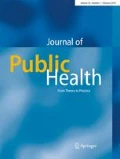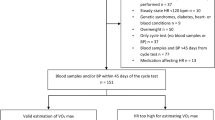Abstract
The question as to whether fitness should be assessed in a European health monitoring system, perhaps from the early stages of life onwards, remains to be answered. We aimed to examine the associations between cardiorespiratory fitness and metabolic risk factors in children. A total of 873 healthy children from Sweden and Estonia aged 9–10 years (444 girls and 429 boys) were randomly selected. A maximal ergometer bike test was used to estimate cardiorespiratory fitness. Additional cardiovascular risk factors were assessed. Significant differences among cardiorespiratory fitness quartiles for the sum of five skinfolds, insulin resistance, triglycerides, and total cholesterol (TC) and high-density lipoprotein cholesterol (HDLc) ratio were shown in girls whereas in boys, the sum of five skinfolds and insulin resistance were significantly different. The lowest sum of five skinfolds and insulin resistance was shown in the highest cardiorespiratory fitness quartile in girls and boys, and the lowest values of triglyceride and TC/HDLc values in the highest cardiorespiratory fitness quartile was observed only in girls. Cardiorespiratory fitness was negatively associated with a clustering of metabolic risk factors in girls and boys. The results add supportive evidence to the body of knowledge suggesting that cardiorespiratory fitness in children is an important health marker and thus should be considered to be included in a pan-European health monitoring system.





Similar content being viewed by others
References
Andersen LB, Hasselstrøm H, Grønfeldt V, Hansen SE, Froberg K (2004) The relationship between physical fitness and clustered risk, and tracking of clustered risk from adolescence to young adulthood: eight years follow-up in the Danish Youth and Sport Study. Int J Behav Nutr Phys Act 1:6
Balady GJ (2002) Survival of the fittest-more evidence. N Engl J Med 346:852–854
Boreham C, Twisk J, Murray L, Savage M, Strain JJ, Cran G (2001) Fitness, fatness, and coronary heart disease risk in adolescents: the Northern Ireland Young Hearts Project. Med Sci Sports Exerc 33:270–274
Boreham C, Twisk J, Neville C, Savage M, Murray L, Gallagher A (2002) Associations between physical fitness and activity patterns during adolescence and cardiovascular risk factors in young adulthood: The Northern Ireland Young Hearts Project. Int J Sports Med 23:22S–26S
Boreham CA, Ferrera I, Twisk JW Gallagher AM, Savage MJ, Murray LJ (2004) Cardiorespiratory fitness, physical activity, and arterial stiffness: The Northern Ireland Young Hearts Project. Hypertension 44:721–726
Brage S, Wedderkopp N, Ekelund U, Franks PW, Wareham NJ, Andersen LB, Froberg K (2004) European Youth Heart Study (EYHS): Features of the metabolic syndrome are associated with objectively measured physical activity and fitness in Danish children: the European Youth Heart Study (EYHS). Diabetes Care 27:2141–2148
Carnethon MR, Gidding SS, Nehgme R, Sidney S, Jacobs DR, Liu K (2003) Cardiorespiratory fitness in young adulthood and the development of cardiovascular disease risk factors. JAMA 290:3092–3100
Church TS, LaMonte MJ, Barlow CE, Blair SN (2005) Cardiorespiratory fitness and body mass index as predictors of cardiovascular disease mortality among men with diabetes. Arch Intern Med 10:2114–21220
Eisenmann JC, Katzmarzyk PT, Perusse L, Tremblay A, Despres JP, Bouchard C (2005a) Aerobic fitness, body mass index, and CVD risk factors among adolescents: the Quebec family study. Int J Obes Relat Metab Disord 29:1077–1083
Eisenmann JC, Wickel EE, Welk GJ, Blair SN (2005b) Relationship between adolescent fitness and fatness and cardiovascular disease risk factors in adulthood: the Aerobics Center Longitudinal Study (ACLS). Am Heart J 149:46–53
Ferreira I, Twisk JW, Stehouwer CD, van Mechelen W, Kemper HC. (2003) Longitudinal changes in VO2max: associations with carotid IMT and arterial stiffness. Med Sci Sports Exerc 35:1670–1678
Ferreira I, Twisk JW, Stehouver CD, van Mechelen W, Kemper HC (2005) The metabolic syndrome, cardiopulmonary fitness, and subcutaneous trunk fat as independent determinants of arterial stiffness: the Amsterdam growth and health longitudinal study. Arch Intern Med 25:875–882
Gulati M, Pandey DK, Arnsdorf MF, Lauderdale DS, Thisted RA, Wicklund RH, Al-Hani AJ, Black HR (2003) Exercise capacity and the risk of death in women: the St. James women take heart project. Circulation 108:1554–1559
Gutin B, Litaker M, Islam S, Manos T, Smith C, Treiber F (1996) Body-composition measurement in 9-11-y-old children by dual-energy X-ray absorptiometry, skinfold thickness measurements, and bioimpedance analysis. Am J Clin Nutr 63:287–292
Gutin B, Yin Z, Humphries MC, Bassali R, Le NA, Daniels S, Barbeau P (2004) Relations of fatness and fitness to fasting insulin in black and white adolescents. J Pediatr 145:737–743
Gutin B, Yin Z, Humphries MC, Bassali R, Le NA, Daniels S, Barbeau P (2005) Relations of body fatness and cardiovascular fitness to lipid profile in black and white adolescents. Pediatr Res 58:78–82
Hansen HS, Froberg K, Nielsen JR, Hyldebrandt N (1989) A new approach to assessing maximal aerobic power in children: the odense school child study. Eur J Appl Physiol Occup Physiol 58:618–624
Hasselstrøm H, Hansen SE, Froberg K, Andersen LB (2002) Physical fitness and physical activity during adolescence as predictors of cardiovascular disease risk in young adulthood. Danish youth and sports study. An eight-year follow-up study. Int J Sports Med 23:27S–31S
Janz KF, Dawson JD, Mahoney LT (2002) Increases in physical fitness during childhood improve cardiovascular health during adolescence: The muscatine study. Int J Sports Med 23:15S–21S
Katzmarzyk PT, Church TS, Blair SN (2004) Cardiorespiratory fitness attenuates the effects of the metabolic syndrome on all cause and cardiovascular disease mortality in men. Arch Intern Med 164:1092–1097
Katzmarzyk PT, Church TS, Janssen I, Ross R, Blair SN (2005) Metabolic syndrome, obesity, and mortality: impact of cardiorespiratory fitness. Diabetes Care 28:391–397
Kurl S, Laukkanen JA, Rauramaa R, Lakka TA, Sivenius J, Salonen JT (2003) Cardiorespiratory fitness and the risk for stroke in men. Arch Intern Med 163:1682–1688
LaMonte MJ, Barlow CE, Jurca R, Kampert JB, Church TS, Blair SN (2005) Cardiorespiratory fitness is inversely associated with the incidence of metabolic syndrome: a prospective study of men and women. Circulation 26:505–512
Lee CD, Blair SN, Jackson AS (1999) Cardiorespiratory fitness, body composition, and all-cause and cardiovascular disease mortality in men. Am J Clin Nutr 69:373–380
Matthews DR, Hosker JP, Rudenski AS, Naylor BA, Treacher DF, Turner RC (1985) Homeostasis model assessment: insulin resistance and beta-cell function from fasting plasma glucose and insulin concentrations in man. Diabetologia 28:412–419
Mora S, Redberg RF, Cui Y, Whiteman MK, Flaws JA, Sharrett AR, Blumenthal R (2003) Ability of exercise testing to predict cardiovascular and all-cause death in asymptomatic women: a 20-year follow-up of the lipid research clinics prevalence study. JAMA 290:1600–1607
Myers J, Prakash M, Froelicher V, Do D, Partington S, Atwood JE (2002) Exercise capacity and mortality among men referred for exercise testing. N Engl J Med 346:793–801
Nielsen GA, Andersen LB (2003) The association between high blood pressure, physical fitness, and body mass index in adolescents. Prev Med 36:229–234
Park MK, Menard SM (1987) Accuracy of blood pressure measurement by the Dinamap monitor in infants and children. Pediatrics 79:907–914
Poortvliet E, Yngve A, Ekelund U, Hurtig-Wennlöf A, Nilsson A, Hagströmer M, Sjöström M (2003) The European Youth Heart Survey (EYHS). An international study that addresses the multi-dimensional issues of CVD risk factors. Forum Nutr 56:254–256
Reed KA, Warburton DE, Lewanczuk RZ, Haykowski MJ, Scott JM, Whitney CL, McGavock JM, McKay HA (2005) Arterial compliance in young children: the role of aerobic fitness. Eur J Cardiovasc Prev Rehabil 12:492–497
Riddoch C, Edwards D, Page A, Froberg K, Anderssen SA, Wedderkopp N, Brage S, Cooper AR, Sardinha LB, Harro M, Klasson-Heggebø L, van Mechelen W, Boreham C, Ekelund U, Bo Andersen L, and the European Youth Heart Study team (2005) Cardiovascular disease risk factors in children: Rationale, aims, study, design, and validation of methods. J Phys Act Health 2:115–129
Twisk JW, Kemper HC, van Mechelen W (2002) The relationship between physical fitness and physical activity during adolescence and cardiovascular disease risk factors at adult age. The Amsterdam growth and health longitudinal study. Int J Sports Med 23:S8–S14
Sjöström M, Poortvliet E, Nelson M (2005) Monitoring public health nutrition in Europe: nutritional indicators and determinants of health status. J Public Health1 3:74–83
Wennlöf AH, Yngve A, Sjöström M (2003) Sampling procedure, participation rates and representativeness in the Swedish part of the European Youth Heart Study (EYHS). Public Health Nutr 6:291–299
Wennlöf AH, Yngve A, Nilsson TK, Sjöström M (2005) Serum lipids, glucose and insulin levels in healthy schoolchildren aged 9 and 15 years from Central Sweden: reference values in relation to biological, social and lifestyle factors. Scand J Clin Lab Invest 65:65–76
Acknowledgements
The Swedish part of the study was supported by grants from the Stockholm County Council (MS), and the Estonian part was supported by a grant from the Estonian Science Foundation No. 3277 and 5209, and by Estonian Centre of Behavioural and Health Sciences. JRR and FBO were supported by a grant from Ministerio de Educación y Ciencia de España (AP2003-2128, AP2004-2745) and CSD (109/UPB31/03, 13/UPB20/04).
Author information
Authors and Affiliations
Corresponding author
Rights and permissions
About this article
Cite this article
Ruiz, J.R., Ortega, F.B., Meusel, D. et al. Cardiorespiratory fitness is associated with features of metabolic risk factors in children. Should cardiorespiratory fitness be assessed in a European health monitoring system? The European Youth Heart Study. J Public Health 14, 94–102 (2006). https://doi.org/10.1007/s10389-006-0026-8
Received:
Accepted:
Published:
Issue Date:
DOI: https://doi.org/10.1007/s10389-006-0026-8




